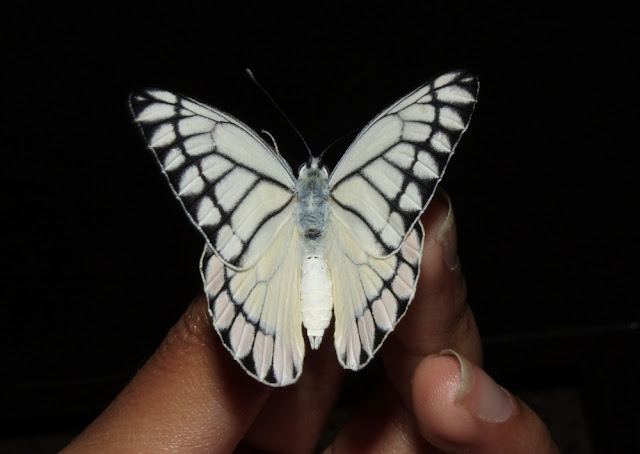A butterfly seen quite often in Bangalore. The larval host plant for this species is Michelia champaka or the Sampige tree.
The egg was found on 27th December 2012.
It hatched on 30th December 2012. This is how it appeared a few hours before hatching:
After hatching the caterpillar measured 2mm. It scratched the surface of the leaves and moved around very slowly.
After the first moult on 3rd January 2013 (day 5), the hairy structures disappeared. The caterpillar's jaws became stronger, as it does with each moult, and the caterpillar began consuming the leaves at a faster rate. Length measurement: 4mm.
The second moult took place on 5th Jan 2013 (day 7). Head cap size increased considerably, and the ventral side became pure white in colour. The caterpillar moved about with greater speed when compared to the earlier instar. One peculiarity is that the caterpillar also walks backwards quite often. The projections on the head part in the last instar, were completely absent in this one. There were absolutely no hairy structures on the caterpillar. The surface was soft and rubbery-textured. On 6th Jan (day 8), it measured 11mm.
The caterpillar moulted again on 10th Jan, 2013 (day 12). This is the final instar of the caterpillar. Measured 30mm just after moulting. This moult changed it's appearance completely. A very prominent "eye" spot on the neck region of the caterpillar. The head size increased, and so did the eating speed. In this instar, the caterpillar ate about 15-20 square centimetres of leaf surface per day. In all the instars, the caterpillar ate only tender leaves and not matured ones. This was few hours after the third moult:
Appearance of the caterpillar on Jan 11th (day 13). Measurement 42mm.
It formed a cremaster and the silken thread (attained pre-pupa stage) on Jan 14th (day 16). It pupated on Jan 15th, sometime during the night. Photograph of the pupa taken on 16th Jan (day 18).
On Jan 28th night, the pupa turned transparent and the wings could be seen. Appearance of the pupa on Jan 29th (day 32) few minutes before the butterfly emerged:
The egg was found on 27th December 2012.
After the first moult on 3rd January 2013 (day 5), the hairy structures disappeared. The caterpillar's jaws became stronger, as it does with each moult, and the caterpillar began consuming the leaves at a faster rate. Length measurement: 4mm.
The second moult took place on 5th Jan 2013 (day 7). Head cap size increased considerably, and the ventral side became pure white in colour. The caterpillar moved about with greater speed when compared to the earlier instar. One peculiarity is that the caterpillar also walks backwards quite often. The projections on the head part in the last instar, were completely absent in this one. There were absolutely no hairy structures on the caterpillar. The surface was soft and rubbery-textured. On 6th Jan (day 8), it measured 11mm.
The caterpillar moulted again on 10th Jan, 2013 (day 12). This is the final instar of the caterpillar. Measured 30mm just after moulting. This moult changed it's appearance completely. A very prominent "eye" spot on the neck region of the caterpillar. The head size increased, and so did the eating speed. In this instar, the caterpillar ate about 15-20 square centimetres of leaf surface per day. In all the instars, the caterpillar ate only tender leaves and not matured ones. This was few hours after the third moult:
Appearance of the caterpillar on Jan 11th (day 13). Measurement 42mm.
On Jan 28th night, the pupa turned transparent and the wings could be seen. Appearance of the pupa on Jan 29th (day 32) few minutes before the butterfly emerged:














































